Looking for a well-balanced pressure cooker recipe? Try Nikujaga, a comforting Japanese home cooked dish, featuring sliced meat, vegetables & potatoes simmered in dashi broth.
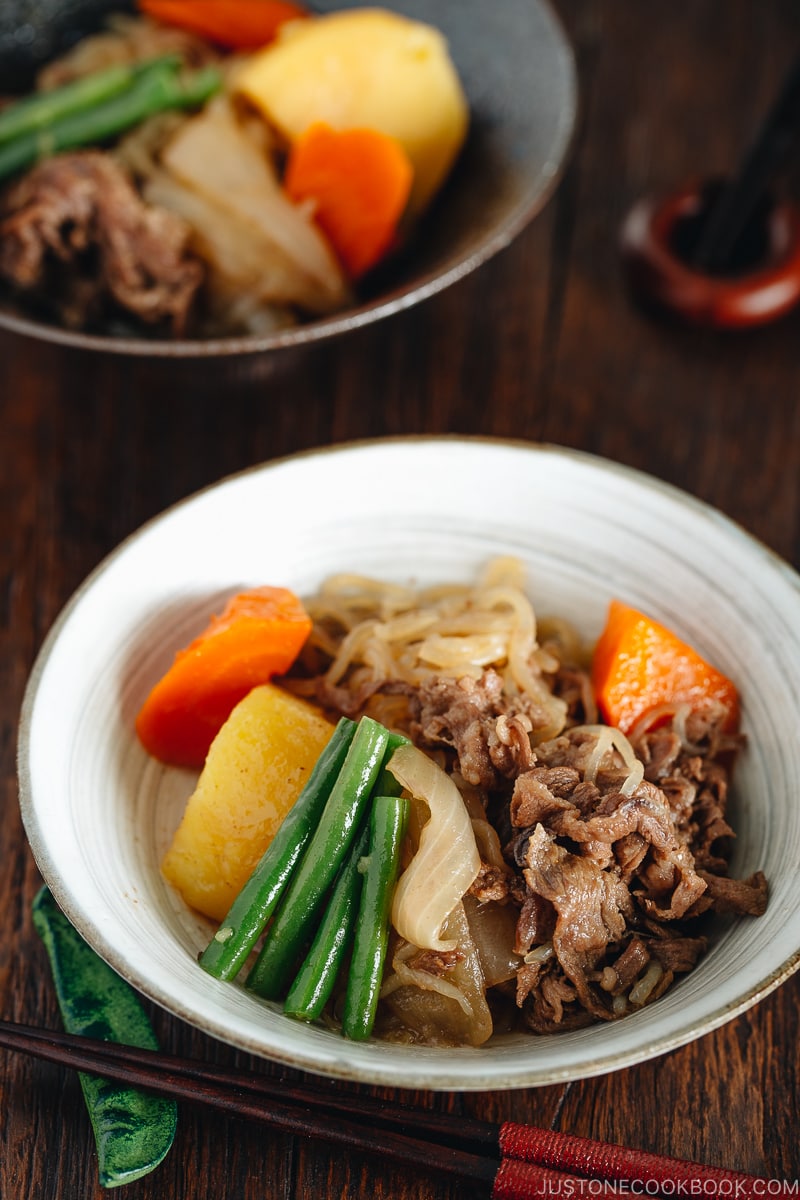
Ever since I fell in love with pressure-cooking foods using my Instant Pot, I’ve been trying to convert some of my favorite stovetop recipes to pressure cooker recipes. Today I’m sharing a classic Japanese home cook dish, Pressure Cooker Nikujaga (圧力鍋で作る肉じゃが).
What is Nikujaga?
Nikujaga, or Meat and Potato Stew (I’m not fond of the translation much), is one of the classic Japanese “mother’s recipes”. I have a regular non-pressure cooker Nikujaga recipe here. Do you have dishes like that in your cuisine? We call this type of dish “ofukuro no aji (おふくろの味)”. It means the flavors/tastes that you are used to and feel nostalgic about, after eating mother’s cooking for years.
Nikujaga is a staple dish to many Japanese. My dad likes potato dishes, so my mom made Korokke and Nikujaga often in her meal rotation when we were growing up. Nikujaga for me is definitely true comfort food.
Simple 4 Ingredients
Niku (肉, にく) in Japanese means meat. Jaga is a shortened word from Jagaimo (ジャガイモ), which means potatoes in Japanese. So Nikujaga always includes meat and potatoes.
Usually, potatoes and thinly sliced beef or pork are simmered in dashi-based soup, seasoned with the standard Japanese condiments – soy sauce, sake, mirin (and sometimes sugar).
Besides meat and potatoes, there are onions and carrots. These four ingredients are almost always in any variety of Nikujaga.
To add some color to this mostly-brown-dish, one type of green vegetable is tossed in at the end, typically green beans or snow peas. Some recipes include shirataki noodles, but they are optional.
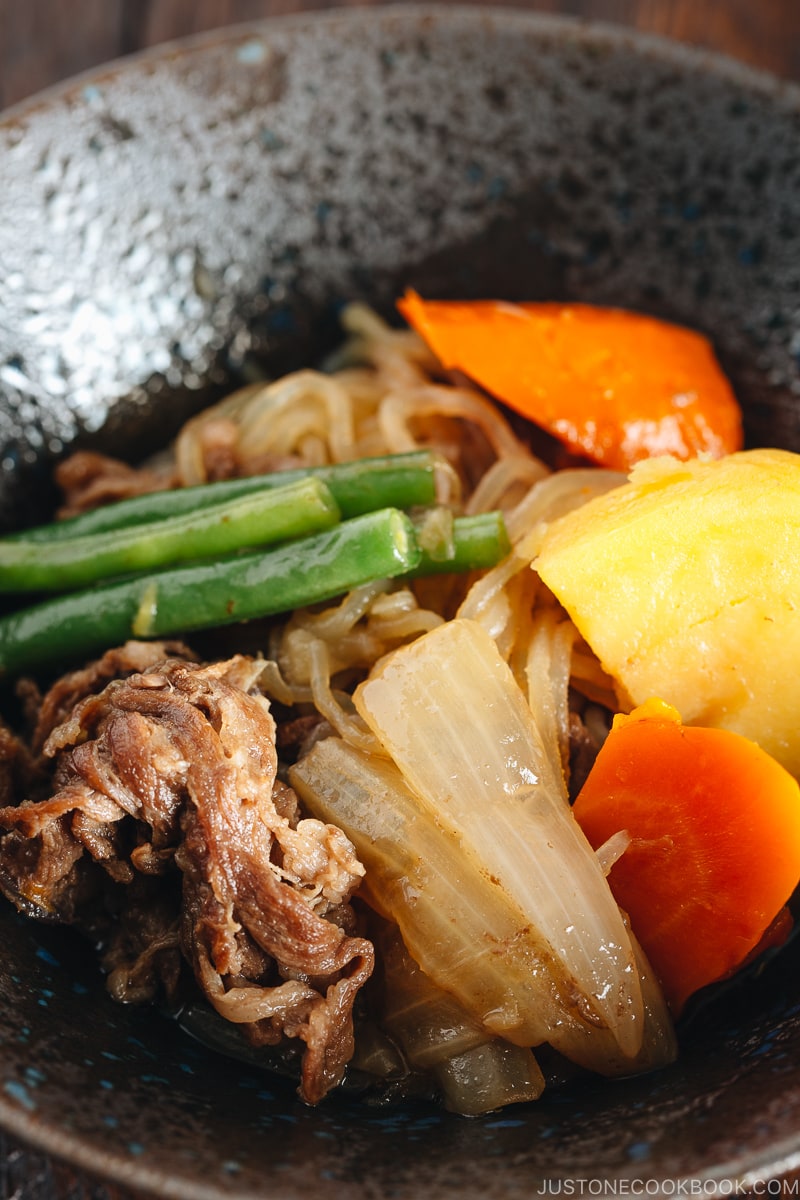
Cooking Tips
I want to share some helpful tips that you can consider implementing when you make this recipe.
- Sauté for more flavors – Sautéing foods first just like you would usually cook on the stovetop adds extra taste. So spend several minutes to brown the meat and vegetables, before adding other liquids and cooking under pressure.
- Cut ingredients into different sizes – Cut the meat into smaller chunks, but luckily many Japanese recipes require thinly sliced meat so you don’t have to worry. If you are cooking a bigger cut of meat, then cut the vegetables slightly bigger than you would usually cut for conventional cooking. That way, the required time to cook each ingredient will be similar. Different ingredients require their own cooking time for the ideal texture and flavor in a pressure cooker. Ideally, for pressure cooking, you want to add and cook ingredients at different time intervals. This is especially true when mixing different types of foods (meat, potatoes, vegetables, etc.). You should start with ingredients that take a long time to cook, such as meat. Since I don’t want to open the pressure cooker halfway through to add the vegetables, I cut my vegetables slightly bigger so they don’t get mushy.
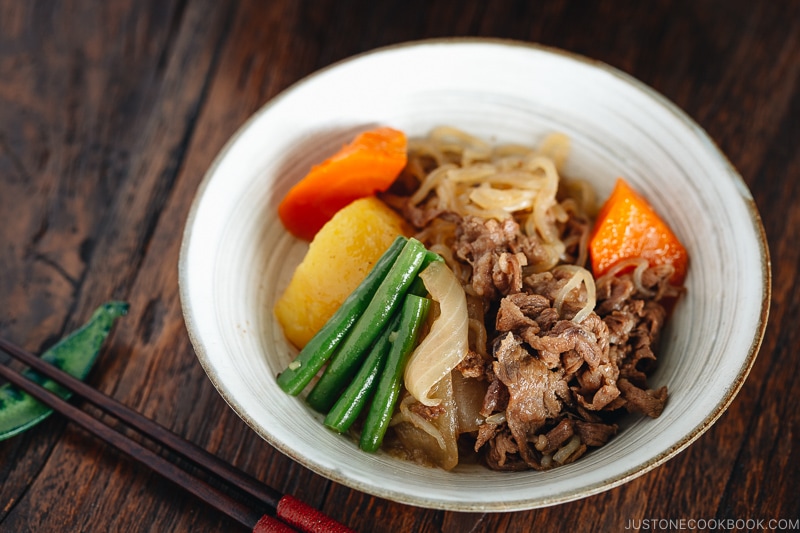
Why I Love Cooking Nikujaga in the Pressure Cooker?
My family and I love Nikujaga. I enjoy the smell of cooking while it’s on the stove. However, I got busier with my work (blogging) and kids’ after-school activities, and I couldn’t find the time to cook Nikujaga anymore. We all missed eating our favorite Nikujaga.
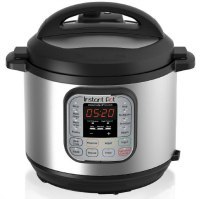
Thanks to the Instant Pot, Nikujaga started to appear on our dinner table once again. Although I would rather stay around in the kitchen watching my Nikujaga being cooked, the best part about Instant Pot is that I can actually leave the house while food is being pressure-cooked. I am not worried about the house being on fire or not having dinner when we go home.
P.S. Just so you know, my Instant Pot recipes are not sponsored by the company. Although they did send me this Instant Pot to try, I’m sharing my recipes because I am very passionate about this cool gadget that could help you make fantastic meals on weeknights.
To quickly explain, this Instant Pot is a 7-in-1 Multi-Functional Cooker. It can be a rice maker/porridge maker, steamer, sauté/browning, yogurt maker, and warmer, but I mostly use the pressure cooker and occasionally slow cooker function.
Try Our Popular Instant Pot Recipes
Check out more Instant Pot recipes on Just One Cookbook!
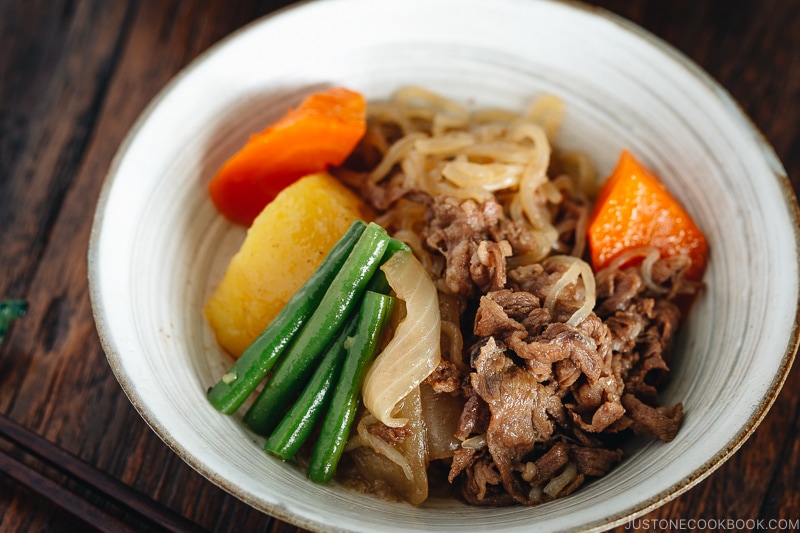
Wish to learn more about Japanese cooking? Sign up for our free newsletter to receive cooking tips & recipe updates! And stay in touch with me on Facebook, Pinterest, YouTube, and Instagram.
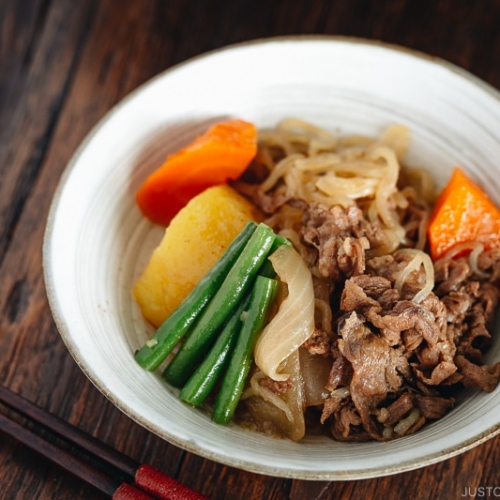
Pressure Cooker Nikujaga
Video
Ingredients
- 10 green beans
- 1 onion
- 1 carrot
- 2 potatoes (I use Yukon gold potatoes as they don‘t break easily compared to russet potatoes)
- 1 package shirataki noodles (7 oz, 198 g)
- ½ lb thinly sliced beef (chuck or ribeye)
- 1 Tbsp neutral oil
- ⅛ tsp Diamond Crystal kosher salt
For the Seasonings
- 1 Tbsp sugar
- 1 cup dashi (Japanese soup stock) (use standard Awase Dashi, dashi packet or powder, or Vegan Dashi)
- 3 Tbsp mirin
- 2 Tbsp sake
- 3 Tbsp soy sauce
Instructions
- Gather all the ingredients.

- Cut 10 green beans in half or thirds. Bring water to a boil in a small saucepan.

- Blanch the green beans for a few minutes until tender. Drain and set aside.

- Cut 1 onion into wedges, then cut them in half.

- Peel and cut 1 carrot into rolling wedges (we call this cutting technique rangiri).

- Peel and cut 2 potatoes into quarters and soak them in water for 10 minutes to remove the starch.

- Open 1 package shirataki noodles and drain the liquid. Cut the shirataki noodles into thirds (or shorter length).

- Cut ½ lb thinly sliced beef (chuck or ribeye) into smaller pieces.

- Press the Sauté button on your Instant Pot (I use 6 QT Instant Pot) and heat 1 Tbsp neutral oil.

- When the pot is hot, sauté the onion. When the onion is coated with oil, add the meat and stir all together.

- Add the potatoes and carrots. Then, add the shirataki noodles.

- Add 1 Tbsp sugar, 1 cup dashi (Japanese soup stock), 3 Tbsp mirin, 2 Tbsp sake, and 3 Tbsp soy sauce.

- Cover and lock the lid. Make sure the steam release handle points at Sealing and not Venting. Press the Keep Warm/Cancel button on the Instant Pot to stop sautéing. Press the Meat/Stew button to switch to the pressure cooking mode. Press the – (minus) button to change the cooking time to 15 minutes.

- If you’re using a stove-top pressure cooker, you won’t have the buttons to press. Just cook on high heat until high pressure is reached. Then, reduce the heat to low but maintain high pressure for about 15 minutes.
- When it is finished cooking, the Instant Pot will switch automatically to the Keep Warm mode. Slide the steam release handle to the Venting position to let out steam until the float valve drops down, OR let the pressure release naturally (takes about 15 mins).
- Unlock the lid and taste the Nikujaga. If necessary, season with ⅛ tsp Diamond Crystal kosher salt. Toss in the blanched green beans to heat up a little, and transfer to a serving dish.

To Store
- You can keep the leftovers in an airtight container and store in the refrigerator for up to 3 days and in the freezer for a month. Potatoes will change their texture, so I recommend removing them first before freezing.
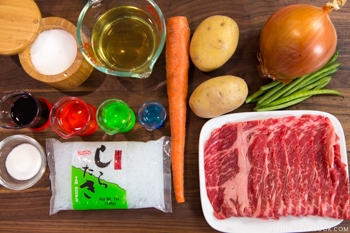
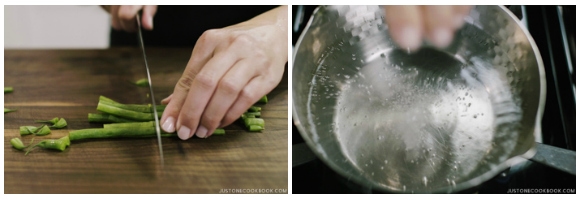
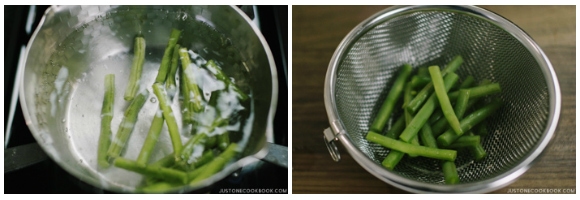
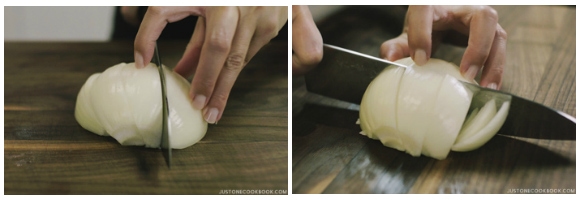
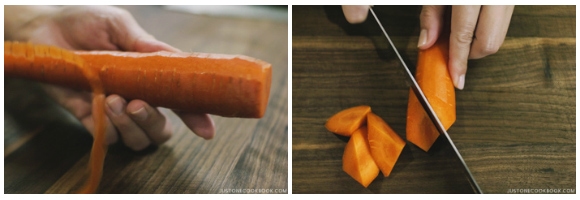
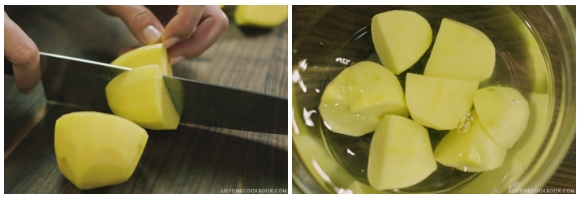

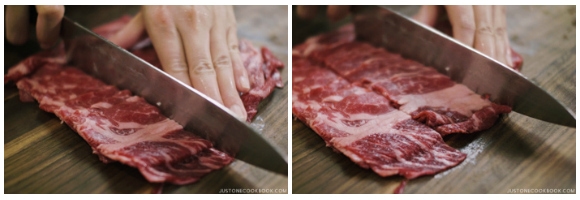
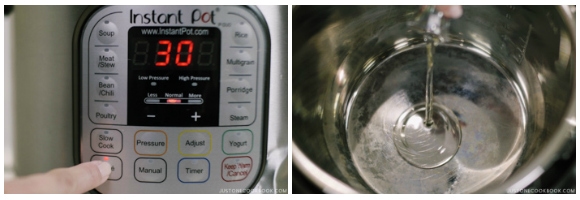
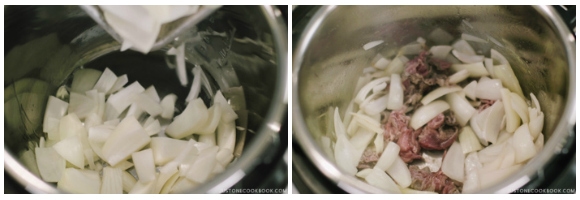
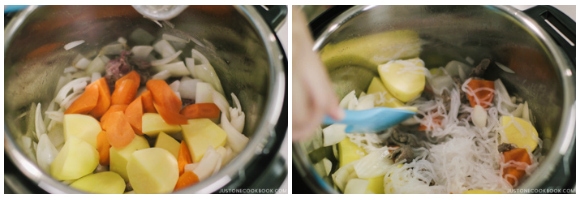














Would it be a good idea to add a little Napa cabbage? Or would that water down the sauce? And in which step should I add it? I’m planning to try this tomorrow…it sounds so good! Thanks for sharing all your great recipes!
Hello, Jade. Thank you for trying Nami’s recipe.
Napa cabbage contains a lot of moisture, which will water down the entire dish if included in this recipe.
How about blanching them with the green beans and adding them to the dish?
You may also adjust the amount of condiments to balance out the flavor of the dish and combine them with other vegetables if desired. (step 10)
We hope this was helpful!
Can you add firm tofu at the end ?
Hi Gi! Sure! You can add Tofu if you like.😊
Here’s Nami’s similar dish with tofu.
https://www.justonecookbook.com/simmered-beef-and-tofu/
We hope you will give it a try! Thank you for trying Nami’s recipe.
Do I have to change anything in the recipe if I’m using a bigger 8qt size Instant Pot for the serving size of 4?
Hi Jay! Thank you for trying Nami’s recipe!
The 8qt Instant Pot requires a minimum of 2 cups of liquid.
So we recommend increasing the serving amount to 6.
We hope this helps!
Hi Nami! I would like to double this recipe. Do you think as long as the ingredients are under the max line I can proceed with the same instructions or do you think this would require adjusting the time? Or maybe best to make two batches? Thank you!
Hi Monika! Thank you very much for trying Nami’s recipe!
The cooking timer you set on your electric pressure starts after your pot reaches pressure. So if you double the recipe, it might take longer to reach pressure, but the cooking time will be the same for the doubled recipe. You can follow the same instruction in the recipe card including the cooking time.
We hope this helps!
Hi! Would gthis work with udon noodles?:)
Hi Olive, Thank you for reading Nami’s post!
If you are adding udon noodles to this dish, we recommend adding cooked Udon noodles at the end (Step 16). The udon noodles will soak up all the soup, and it will not cook well the other ingredient if you add it early.
We hope this helps!
I love the taste of your food and the detailed instructions but this time it failed! 1 cup is NOT enough dashi for this recipe. My instant pot got burnt! Need more dashi or reduce pressure cook time from 15min! Perhaps write in the notes some tips on how to calibrate the amount of dashi to put in the pressure cooker so the food doesn’t get burnt as the dashi completely evaporate!!
Hi Elisabeth, We are sorry to hear your Nikujaga came out burnt.😞
Please make sure your pressure cooker was correctly sealed to keep the moisture inside.
This recipe’s total liquid is 1.5 cups include soy sauce, mirin, and sake. So it should be plenty of liquid left after finish cooking.
If you skip any of the liquid condiments, please replace them with water or dashi.
We hope this helps!
Omg so simple and easy to make and soooooo delicious! Always missed this dish back home and travels in Japan. 🥰🥰🥰
Hi Samantha!
Thank you very much for trying this recipe and for your kind feedback! 😊
If I’d like to add noodles to this dish, but do not have access to shirataki noodles, is there a good alternative?
Hi Scott,
The texture will be different from Shirataki noodles, but how about Malony Glass Noodles or Harusame?
Just made this for the first time. It is soooooo delicious! I wasn’t sure about the yam noodles, but they were perfect with the beef and vegetables. Will definitely make this again. Thank you so much for introducing me to this recipe!
Hi Bern,
Thank you so much for trying this recipe and for your kind feedback.
We’re so glad to hear you enjoyed the dish and make this again! 😊
Hi Nami! Thank you so much for your tireless efforts to teach us Japanese cooking! Nikujaga is one of my favourite recipes from JOC. I’ve cooked this several times over the winter months here in Canada and it really hits the spot! This is such an easy, but flavourful dish that is perfect for working folks like me.
Hi Elizabeth! Aww, it’s my pleasure! I’m so happy to hear you enjoy this recipe! Thank you for your kind feedback. xoxo
This is so delicious. I didn’t think I could get this flavor at home, but the taste of this recipe is so right and so easy to make. Personally I think the seasoning is just perfect, but my husband likes things a little bit more savory, like the restaurant. So next time, I’ll try an extra tsp of sugar and an extra pinch of salt, especially if we serve it with udon instead of the Konjac noodles.
Hello! Yeah, if you serve udon, it’s possible that you introduce more water as you add the noodles. I hope the next batch will be a perfect one! Thank you so much for trying this recipe! xoxo
Hi NAMI,
Thank you for the recipe.just wanting to quadruple the recipe and make it into a main meal. How much liquid or seasoning should I put in. I know It is not linear , if you don’t know the answer , is there a way to find out? How did you come up with the seasoning and one cup of dashi?
Blessings
Jay
Hi Jay! I apologize for my late response. I had been sick and couldn’t get back to you sooner to answer this question. To make sure flavors are soaked in the ingredients, it’s safe to multiply – BUT depending on the size of the pot, you don’t always need to… which is why we need to test and see how it goes. I haven’t quadruple the recipe so I can’t tell for sure… I like mine to have some sauce but other recipes don’t. Some have more sauce… so it also depends on how you enjoy it – over rice, as a side dish, etc etc…
I made this today, and recipe worked well, but was too sweet for me. I prefer half the sugar of this recipe.
Hi Voly! Thank you so much for trying this recipe and for your kind feedback! 🙂
Nami, I made this for dinner. It was a big hit with everyone. And it came together so quickly for a terrific weeknight meal. I love my instant pot. I served this stew with miso soup, steamed rice and cucumber salad. What would you serve it with?
Hi Christine! Thank you for trying this recipe! I’m so happy to hear you enjoyed it. Hmm, I’d probably served grilled fish to add more protein. 🙂
[…] Nikujaga (Meat & Potato Stew) […]